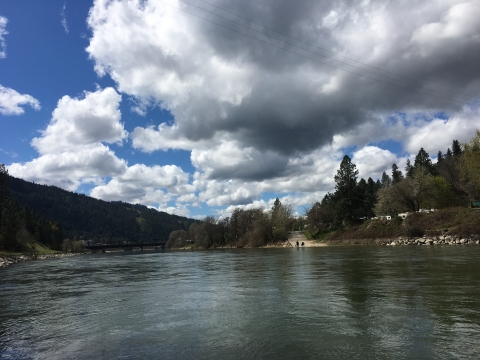Projects and Research
Watercraft Safety Coordination
Watercraft Safety Coordination for U.S. Fish and Wildlife Service Regions 1 &8 is conducted out of the Idaho Fish and Wildlife Conservation Office. Training is required for DOI personnel who operate motorboats, and anyone who operates DOI motorboats. Courses are offered to cooperators and non-DOI Federal employees whenever space is available.
Fall Chinook Salmon
Historically the core population of Snake River fall Chinook salmon spawned upstream of where the Hells Canyon Complex of Dams (Hells Canyon, Oxbow, and Brownlee) now lies. The Hells Canyon Complex was designed to allow fish passage fish passage
Fish passage is the ability of fish or other aquatic species to move freely throughout their life to find food, reproduce, and complete their natural migration cycles. Millions of barriers to fish passage across the country are fragmenting habitat and leading to species declines. The U.S. Fish and Wildlife Service's National Fish Passage Program is working to reconnect watersheds to benefit both wildlife and people.
Learn more about fish passage , but the system did not work and spawning upstream of the Hells Canyon Complex ended by the late 1960’s. By the mid 1970’s, four dams (Ice Harbor, Lower Monumental, Little Goose, and Lower Granite [add weblinks later]) were in place on the lower Snake River. The lower Snake River dams allowed fish passage and currently most fall Chinook salmon spawning occurs within the 173 km free-flowing reach of the Snake River between Lower Granite and Hells Canyon dams and the lower reaches of Snake River tributaries including the Imnaha, Salmon, Grande Ronde, and Clearwater Rivers.
The placement of dams on the Snake River required mitigation to ensure a viable population of fall Chinook salmon was maintained. The main approach was to establish a hatchery stock of Snake River fall Chinook salmon by trapping spawners at dams and rearing their offspring at hatcheries. Lyons Ferry Hatchery [add weblink later] was constructed for this purpose and reared its first brood in 1984.
Even with mitigation efforts, by 1992 the Snake River fall Chinook salmon population was low enough to merit listing under the Endangered Species Act. Determining how to recover the population required information on wild fall Chinook salmon that did not exist. Thus, staff of the Idaho Fish and Wildlife Conservation Office began a long-term series of cooperative research projects to collect needed information and help managers plan and evaluate recovery efforts. Our cooperators presently include the Idaho Power Company, Nez Perce Tribe Department of Fisheries Resources Management, National Oceanographic and Atmospheric Administration Fisheries, Pacific Northwest National Laboratory, U. S. Geological Survey, University of Idaho, University of Washington, and Washington Department of Fish and Wildlife. Research projects have and continue to address: 1) the genetic characterization of wild Snake River fall Chinook salmon; 2) contemporary spawning distribution, 3) juvenile life history diversity and growth, 4) behavior of juveniles during seaward migration, 5) survival of juveniles during seaward migration, 6) the efficacy of supplementation, and 7) the efficacy of summer transportation and spill.
Mountain Whitefish
The study of mountain whitefish (Prosopium williamsoni) began in 1992 as part of the Fishery Resource Status and Trends program developed by the U.S. Fish and Wildlife Service. It was conducted under the Global Climate Change component designed to collect long-term population and environmental data for specific fish species. The area of study was Killed Creek and Crooked Fork creeks which are located in the headwaters of the Lochsa River drainage near the Idaho/Montana border. Mountain whitefish inhabit cold, low gradient streams and, in Idaho, are most often found in streams 15 meters in width or greater. Very little is known about the life history, status, and habitat requirements of mountain whitefish. Northcote and Ennis have attributed the lack of research of P. williamsoni to it being a species of less appeal to anglers.
Fish Tracking Radio Tags
Radio tags are used by the Idaho Fish and Wildlife Conservation Office to study the movements of salmon and steelhead.
One ongoing study being conducted by our biologists involves radio-tagging adult steelhead to determine their spawning distribution. The target fish are unclipped hatchery fish released as juveniles in tributaries of the South Fork Clearwater River in hopes they will return to their release location and spawn. By unclipped, we mean their adipose fin is intact and thus the fish cannot be legally harvested. In addition to releasing the fish unharmed, we would prefer that anglers do not pull radio tags from unclipped hatchery steelhead so that we can track the fish to their spawning location.
The University of Idaho has long been radio-tagging salmon and steelhead in the Snake River basin. Their studies benefit from having fish captured and radio tags returned, and to promote the collection of radio tags they offer cash awards for tag returns. We do not offer any monetary awards because having the radio tags removed from our study fish reduces our chances of determining spawning distribution. However, if you did remove the radio tag there is no penalty and we would greatly appreciate the information on the tag, as well as when and where you caught the fish.

